Other factors besides choke constriction influence pattern size, and only through testing can you learn how a load performs in your gun.
Just because your shotgun choke is labeled modified doesn’t mean it will shoot a modified pattern. Modern barrels contain longer forcing cones and chokes that treat shot tenderly to keep it flying straight. Hard and round pellets padded with buffers and cushioned by plastic wads further contribute to tight patterns.
Early shotshells had paper, cork or felt wads. These provided little protection for shot. The hard paper nitro wad did a poor job of sealing the bore, and powder gases blasted past the shot.
Those wads also did nothing to protect pellets as they grated downbore. Along came plastic, and shotshell wads changed for the better.
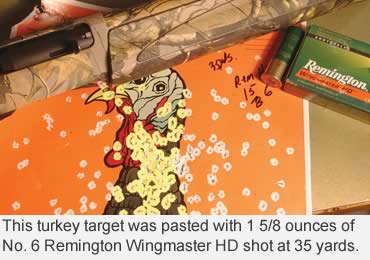 One-piece plastic wads protect shot in several ways. Their concave base acts like a skirt to seal the bore against the powder gases. Above the base, legs, posts or even circles of plastic compress to work like springs, cushioning shot on acceleration. The shot cup walls protect the shot from scraping against the bore, significantly reducing pellet deformation.
One-piece plastic wads protect shot in several ways. Their concave base acts like a skirt to seal the bore against the powder gases. Above the base, legs, posts or even circles of plastic compress to work like springs, cushioning shot on acceleration. The shot cup walls protect the shot from scraping against the bore, significantly reducing pellet deformation.
Many factory magnum loads have granulated plastic sifted in among the pellets. The granules function like tiny pillows to keep pellets from mashing into each other so they fly truer once they leave the barrel.
Modern Shot
Over the decades, shot has evolved from plain lead to hard shot that flies straight. Lead shot that contains about 6 percent antimony resists deformation much better than plain lead shot. So does nickel- and copper-plated lead shot, and steel and tungsten-based pellets.
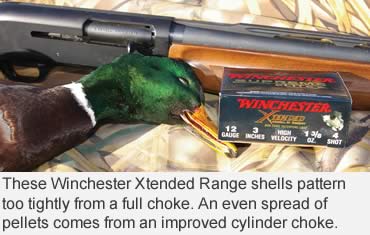 Fiocchi’s Exacta Premium White Rhino 12-Gauge shells with 1 1/8 ounce of 7 1/2 shot with 5 percent antimony shoots patterns of 92 percent from the improved cylinder choke in a Smith & Wesson Elite over/under. Exacta Premium Crusher loads with 1 ounce of 7 1/2s shot patterns of 67 percent. That’s 37 and 12 percent more shot than the standard 55 percent an improved cylinder choke should put in a pattern.
Fiocchi’s Exacta Premium White Rhino 12-Gauge shells with 1 1/8 ounce of 7 1/2 shot with 5 percent antimony shoots patterns of 92 percent from the improved cylinder choke in a Smith & Wesson Elite over/under. Exacta Premium Crusher loads with 1 ounce of 7 1/2s shot patterns of 67 percent. That’s 37 and 12 percent more shot than the standard 55 percent an improved cylinder choke should put in a pattern.
Remington’s Nitro Turkey 12-gauge 3-inch loads of 1 7/8 ounce of extra-hard lead shot 5s fired from a Remington Model 870 with modified, full and extra-full chokes patterned nearly all the load’s pellets in a 30-inch circle at 40 yards, and 35 to 37 percent of the load’s shot in a 15-inch circle at 40 yards.
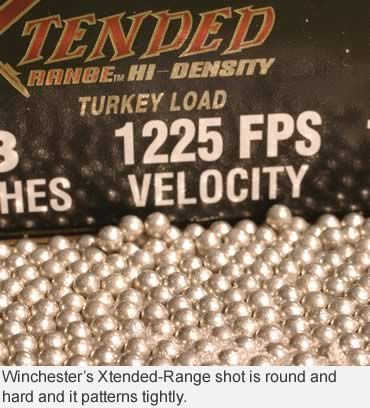 Steel shot is round and hard, so its wad needs no cushioning legs or shot cup to keep it from deforming. Because steel shot is harder than the steel in a shotgun barrel, the thick walls of shot cups are needed to protect the barrel.
Steel shot is round and hard, so its wad needs no cushioning legs or shot cup to keep it from deforming. Because steel shot is harder than the steel in a shotgun barrel, the thick walls of shot cups are needed to protect the barrel.
Some of my handloads of 1 1/8-ounce steel 2s pattern upwards of 90 percent at 40 yards from a Benelli Nova 12-gauge with a light-modified choke. From a Smith & Wesson Elite improved cylinder choke, Fiocchi’s Steel Target load with 7/8-ounce 7s patterned 72 percent.
Patterns enlarge quite a bit at longer distances when shooting smaller steel at high velocity, perhaps due to increased air resistance causing steel shot’s relatively light pellets to flare.
Tungsten-based nontoxic shots produce very dense patterns. However, they do not always respond to an increasing amount of choke the same as lead shot.
To determine which choke produces the tightest cloud of pellets at 40 yards, I shot several 12-gauge 3-inch loads of Federal Heavyweight, Remington’s Wingmaster HD and Winchester Xtended Range through three different screw-in chokes in a Remington 11-87 Sportsman Super Magnum Sunspot turkey shotgun. The Remington chokes were modified (.712 inch) full (.695 inch) and an extra-full Wingmaster HD choke (.675 inch).
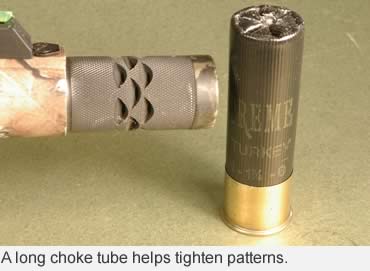 Federal’s 1 5/8-ounce Heavyweight 7 load shot its tightest pattern with a full choke. Patterns of Heavyweight 6s really didn’t show much difference with the modified, full or extra full chokes.
Federal’s 1 5/8-ounce Heavyweight 7 load shot its tightest pattern with a full choke. Patterns of Heavyweight 6s really didn’t show much difference with the modified, full or extra full chokes.
Remington’s Wingmaster HD pellets are made of an alloy of tungsten, bronze and iron. There wasn’t much difference in the number of pellets in patterns with modified, full or extra full chokes.
Winchester’s Xtended Range pellets are an alloy of tungsten, iron, copper and tin. The Xtended Range load of 1 3/4-ounce 6s responded well to an increase in choke and added pellets to patterns at 40 yards all the way up to the extra-full choke.
The Xtended Range 5s’ pellet count increased up to full choke and fell off slightly when shot through the extra-full choke.
Bores and Chokes
How a bore is constructed influences pattern sizes. A forcing cone with a gradual taper helps reduce the pressure on lead shot, but it means little with steel or tungsten-based shot because they are so hard.
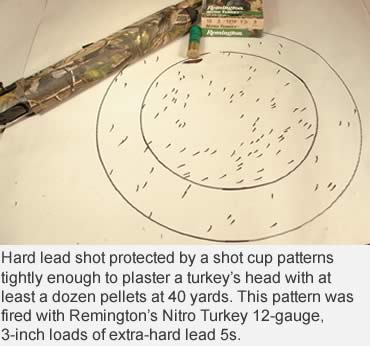 Some shotguns, like the Winchester Super X3, have back-bored barrels with a bore diameter of .742 inch, compared to the standard .729-inch bore. Opinions are mixed whether this wider bore patterns large shot tighter than standard barrels.
Some shotguns, like the Winchester Super X3, have back-bored barrels with a bore diameter of .742 inch, compared to the standard .729-inch bore. Opinions are mixed whether this wider bore patterns large shot tighter than standard barrels.
A proper choke tapers gradually from bore diameter to the beginning of the constriction. The constriction should have a parallel long enough to hold the load, about 3/4 to 1 inch. The longer the parallel section, the tighter a load shoots.
The old Browning A-5 had as much as 6 inches of choke. My A-5 has a fixed modified choke and has always delivered 75 percent and tighter patterns. This long choke length is quite popular today. Some screw-in choke tubes protrude from a shotgun muzzle like an anteater snout.
There are some general guidelines on what amount of choke shoots best with different shots, wads and shotgun bores. But the best results require patterning your shotgun to find the best choke and load combination for your shotgun.
Read Recent GunHunter Articles:
• Muzzleloader Tune-up: To the uninitiated, muzzleloaders are veiled in a cloak of mystery. To hunters who understand them, blackpowder rifles are simple and predictable in operation.
• Bear Bait: My right leg throbbed with every step as I plowed through the knee-deep snow...
This article first appeared in the August 2011 issue of Buckmasters GunHunter Magazine. Subscribe today to have GunHunter delivered to your home.